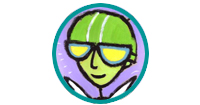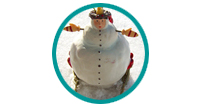The Short Answer: A group of friends paying attention to things that are hopeful, beautiful, silly, tasty, helpful, interesting, infuriating, ordinary, and sometimes y.
The Long Answer: The name comes from an editorial that Karen wrote for the arts magazine we used to publish and it goes a little something like this:

Illustration: Rachell Sumpter
Across the street and down the alley from my office, a group of small brown birds spends its days inside the branches of a backyard hedge. I have become well acquainted with their conversation, which is often loudest on days when I have had to dress in substantial layers to protect my skin from frostbite.
From time to time, I wander into that alley, past garbage cans and overgrown grass, to see how the birds are doing. When I walk by they fly away almost immediately. But when I drive by slowly and lower the window, they barely notice me. I have seen an especially talented cat stealthily make his way through the branches two feet off the ground in the hopes of being invited to lunch.
The sight and sound of these birds gives me hope. Neighbors have come and gone. Developers are moving in, yanking out our 1950’s bungalows and changing the face of the neighborhood with massive houses. But year after year the Hedge Society continues to meet and vote the cat out of the branches.
Hope sounds easy, but I have a hard time with it. It’s an ethereal word — a sound that exits the mouth in a bit of a whisper, almost a sigh. I thought that spending a few months putting together an issue on hope and possibility would leave me with a solid sense of what hope really is, would bring me the sun in my sky, the spring in my step, the whiskey in my coffee.
But how hope comes to us remains a mystery to me. Hope is an essential element for those who think in possibilities, for those who enact justice, reconciliation, health, and beauty. Hope is more than optimism’s cheery cousin, making itself known in the most impossible of circumstances.
Yet the more I try to name hope, the more elusive it becomes. Richard P. Feynman, physicist and Nobel Prize winner, told a story of how his father taught him about the world.
“…one kid said to me, “See that bird, what kind of a bird is that?” And I said, “I haven’t the slightest idea what kind of a bird it is.” He says, “It’s a brown throated thrush,” or something, “Your father doesn’t tell you anything.” But it was the opposite: my father had taught me. Looking at a bird he says, “Do you know what that bird is? It is a brown throated thrush; but in Portuguese it’s a…in Italian,” he says “in Chinese it’s a …, in Japanese a …,” etcetera. “Now,” he says, “you know in all the languages you want to know what the name of that bird is and when you’ve finished with all that,” he says, “you’ll know absolutely nothing whatever about the bird. You only know about humans in different places and what they call the bird. Now,” he says, “let’s look at the bird.”
Emily Dickinson may have had her own Hedge Society when she chose to “look at the bird.” “Hope is the thing with feathers,” she wrote, “that perches in the soul.” Feathers appear to be yet another wispy thing. But a closer look and a twirl between thumb and forefinger, reveals a shaft —the skeletal bit the feather emerges from. That combination of skeleton and fluff not only enables flight but creates warmth and beauty. And birds are extremely careful with these feathers, spending half their time preening, paying attention to these things that ensure their very survival.
Hope needs to be cared for, cultivated, but how do you cultivate something so mysterious and yet so necessary to being human?
Victoria Stafford writes, “Our mission is to plant ourselves at the gates of Hope… a different, sometimes lonely place, the place of truth-telling, about your own soul first of all and its condition, the place of resistance and defiance, the piece of ground from which you see the world both as it is and as it could be, as it will be; the place from which you glimpse not only struggle, but joy in the struggle. And we stand there, beckoning and calling, telling people what we are seeing, asking people what they see.”
We beckon by looking at the many manifestations of the thing with feathers, rolling down windows and paying attention to Hedge Societies in all kinds of alleyways.








